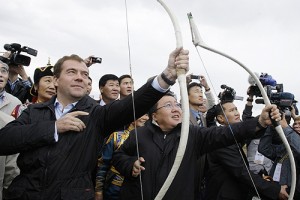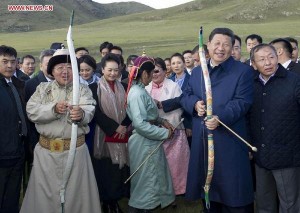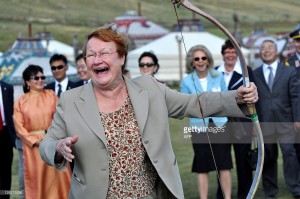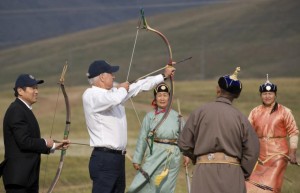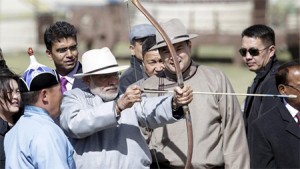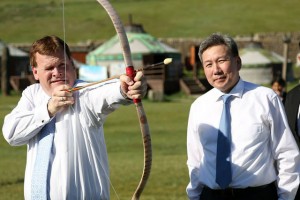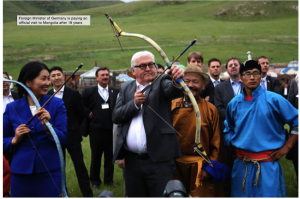A Conversation With Asim Arun
One of the things I really like about the broad variety of disciplinary academic perspectives on Mongolia that I come in contact with (for example, a lot of the discussions at the recent Oxford Deserts Conference), is that I get to learn a lot in the process of this contact. The same can be said about different discussions that centre around a specific issue.
Here, I’m writing together with Asim Arun who is an MA Candidate in our Asia Pacific Policy Studies program. Asim is a government officer from India on a mid-career study break.
We were having a discussion about Indian PM Modi’s recent visit to Mongolia and the extent to which PM Modi has emerged as a foreign policy actor. This followed on his election more or less on a domestic agenda focused on anti-corruption. This in turn gave me occasion to learn about anti-corruption activities in India from Asim and to think about how these might apply to Mongolia if at all.
Corruption in Mongolia
First, let’s set the stage for a discussion of corruption in Mongolia. This is clearly a serious issue. Petty corruption, systemic corruption, as well as grand corruption appear to be wide-spread if not endemic in Mongolia. It is important to note that grand corruption in particular essentially amounts to theft from the Mongolia people.
I have always been amazed by the extent to which corruption seems wide-spread in Mongolia and leads to some of the vast inequalities that can be observed, for example, in the kind of cars that can be seen on Ulaanbaatar streets today. Clearly, evidence is scarce, but there’s so much smoke around the topic of corruption that it is unimaginable to me that there isn’t a corrupt fire. Note that I’m concerned with corruption somewhat in the abstract here, not with particular cases or individual actors.
Anti-Corruption Efforts in Mongolia
The Civil Will Green Party has probably talked about the scourge of corruption for the longest time among the parties that continue to be active in Mongolian politics. Yet, despite the credibility on this issue by some of its leaders, most notably perhaps MP S Oyun, even CWGP has not – in my observations – made corruption the centre of its agenda or campaigning and appealed directly to the citizenry on the need to address corruption.
The Democratic Party has also talked about corruption for some time and President Ts Elbegdorj has been particularly vocal in this area. Yet, the last several years of a DP-led government have been disappointing in this regard. For the most part, anti-corruption activities seem to have focused on political opponents of the DP, or sometimes opponents of individual DP leaders. The Anti-Corruption Agency has lost some of its independence in this regard and many Mongolians now appear to see it primarily as an agent of the presidency.
If we think of the past several years as essentially a failure and lost time when it comes to the bigger fight against corruption (not that there haven’t been successes like the Extractive Industries Transparency Initiative or the enforcement of financial reporting by MPs), what strategies can we imagine that might be more successful?
Why India?
Here’s where my discussion with Asim was interesting to me as offering some possible lenses on Mongolia: Not only have India-Mongolia relations seen a recent highlight with #ModiInMongolia, but these are two of a rare breed, democracies in Asia. They serve an important signalling function for the rest of Asia, India obviously more so given its size and longer history of democratic governance, but Mongolia as well (as I discussed in a recent East Asia Forum Article, “Can Freedom Go Online in Asia?” with other MAAPPS students Trevor Kennedy, Christina Toepell and Melanie Schweiger).
Not only are Mongolia and India democratic, but they are generally seen as somewhat chaotic democracies. They might also be somewhat similar in the nature of their media: lots of it, but low journalistic standards across a wide spectrum of media outlets. On the issue of corruption, some of these low standards have meant that discussions are focused on scandals and that that the “discovery” of such scandals happens in a tabloid style and is rarely backed up by evidence.
Part of the chaos associated with these democracies is corruption:
In international comparisons, India and Mongolia look quite similar when it comes to corruption. In Transparency International’s 2014 Corruption Perception Index, the prevalence of corruption is perceived to be at similar levels in the two countries, as they receive a score of 38 (India) and 39 (Mongolia), ranking right in the middle of the 175 countries included at 85th and 80th, respectively. The Heritage Foundation’s Index of Freedom allows a side-by-side comparison of its “Freedom from Corruption” category (which is “derived primarily from Transparency International’s Corruption Perceptions Index (CPI) for 2010, which measures the level of corruption in 178 countries.“).
In many areas, the differences between India and Mongolia are so vast that they almost seem like incomparable cases. Population size and density, religious and ethnic diversity, the existence/remnants of caste society, geopolitical situation, etc.
Yet, there is another big difference between India and Mongolia: in India, corruption has become a prominent political issue that is not just paid lip service to, but that has swayed elections. That does not mean that corruption has been rooted out in India, nor that it is set to disappear any time soon, but there has been significant mobilization around the issue, a context that would seem to be one of the preconditions for any real attempts to address this issue.
A Chronology of Recent Indian Mobilization
With the Right To Information Act (RTI) coming into being in 2003, various levels of the government were forced into transparency and numerous instances of corruption- grand and petty, started coming to light. The Comptroller and Auditor General (CAG) pointed out large-scale state capture corruption in mining where instead of a transparent auction of coal blocks ‘allotments’ were made to companies in which members of the ruling coalition led by the Indian National Congress had interests. Similarly, the process of allocation of radio spectrum frequencies, another natural resource, was opaque and arbitrary. The CAG estimated the loss to the government in Coal-gate at USD 34 billion and the spectrum scam at USD 30 billion!
While news of such grand corruption occupied prime time, citizens struggled with petty corruption in their day-to-day lives. RTI activism gained support to evolve into a strong civil society movement which reached a crescendo in 2011 with India witnessing a massive campaign under Gandhian septuagenarian leader, Anna Hazare. Anna’s prime demand was the creation of a strong anti-corruption agency called Lokpal that, as in Hong Kong and Singapore, would become the main cleansing agent. To silence the growing movement, the Congress-led government reluctantly passed the Lokpal bill in Parliament but did nothing to implement it. Anna’s movement lost steam as its prime players could not work together for long and went their ways. A large chunk founded a political party – Aam Aadmi Party (Common Man’s Party) and in 2013 could manage 27 out of 70 seats in Delhi’s provincial elections. They even formed the government, ironically with Congress’ support, but resigned on its 49th day having realized the futility of running a minority government.
Sensing the mood of the electorate, Narendra Modi and his Bhartiya Janata Party (BJP) made anti-corruption the main plank of their 2014 federal election campaign and succeeded in sweeping it. In February 2015, fresh elections were held in Delhi and the AAP, this time, won all but 3 seats to the 70 member state assembly! Clearly, anti-corruption is the flavour of the season. In India today, no party can step into an election campaign staying silent on this issue. This bottom-up or demand-driven anti-corruption movement has mounted pressure on the government to reform procedures and cure corruption because the voters are not likely to forgive non-performance on this count.
In contrast, President Xi Jinping’s campaign in China is being criticised for employing a top-down approach. Without freedom of expression, democracy and, a vibrant and vocal civil society even if a demand for curing corruption exists, it does not aggregate into a movement. Mongolia has the advantage of the existence of these dimensions of a free society and it should not be difficult for people from all walks of life to come together against corruption in such a way that no political party can afford to ignore the malaise any longer.
Implications for Mongolia
India’s example of cosmopolitan, if somewhat urban, anti-graft movement holds lessons and inspirations for Mongolians. State capture or grand corruption can be controlled only by creating a strong and smart agency to track, try and, punish the corrupt actors. Petty or street corruption can be best addressed by creating complaint helplines and then helping the complainant organize a trap by using surveillance cameras in such a way that it becomes legally admissible evidence. This could be done by a government serious about the cure or even an apolitical activist organization. The idea is to bring corruption centre stage. In India, the media played, and continues to do so, the role of a catalyst as prime time TV and front pages of newspapers are occupied by news of corruption and anti-corruption.
An important dimension, where India has not made much of a breakthrough, is eliminating the imperative need for black money for financing political parties. A transparent process of political funding has to be worked out to get rid of systemic corruption which, in turn, needs out of the box thinking by a fresh bunch of people who believe that change is possible.
At the same time, it should be noted on the Indian example, that anti-corruption does appear to hold the transformative potential to mobilize the electorate around a single issue. Whether that leads to a new party like the AAP in Delhi, or forces existing political parties to adopt anti-corruption in its platform as now-PM Modi did in the 2014 general election, on top of civil society mobilization anti-corruption efforts can clearly galvanize the electorate. In the Mongolian context, it’s difficult to imagine any of the three biggest political forces, DP, MPP or Justice Coalition, to adopt a credible anti-corruption stance, but the Indian example seems to suggest that existing political forces, especially the CWGP or independents, as well as emerging political parties, may well turn to anti-corruption as a campaign theme. Such a theme would presume that civil society mobilization is not a necessary condition in bringing anti-corruption efforts to the political fore, as we’ve seen only a limited amount of mobilization around this theme.
In terms of institutional design, Mongolia might consider creating the role of a Comptroller and Auditor General (or expanding that role if it exists to some degree). Rather than making that an anti-corruption role only – and thus locating it within the Anti-Corruption Agency – a broader independent role to assess government accounting and procurement as the Canadian Auditor General has, might offer a number of additional benefits.
While some anti-corruption efforts like the Extractive Industries Transparency Initiative are focused on the payments that industry makes to government, there’s significant less attention paid to what government does with money that it receives. Scrutiny of some government programs without turning that into a potential instrument for a witch-hunt or partisan persecution, could give greater impetus to transparency efforts in other areas.

 Follow
Follow